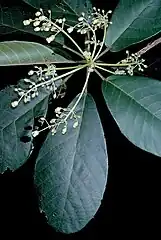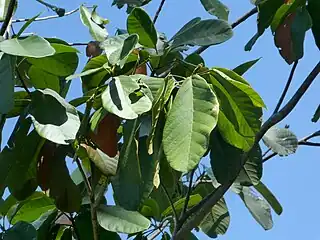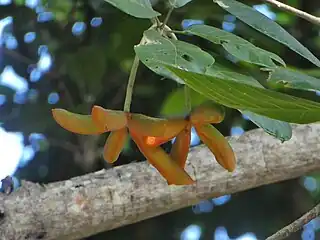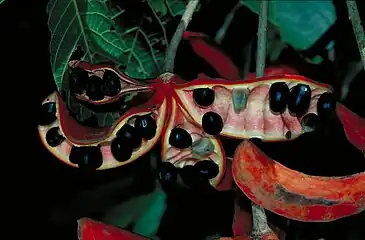| Lacewood | |
|---|---|
 | |
| Scientific classification | |
| Kingdom: | Plantae |
| Clade: | Tracheophytes |
| Clade: | Angiosperms |
| Clade: | Eudicots |
| Clade: | Rosids |
| Order: | Malvales |
| Family: | Malvaceae |
| Genus: | Sterculia |
| Species: | S. shillinglawii |
| Binomial name | |
| Sterculia shillinglawii | |
Sterculia shillinglawii, commonly known as tulip sterculia or lacewood, is a tree in the family Malvaceae which is native to Papuasia and northeastern Australia.
Description
Sterculia shillinglawii is a rainforest tree growing up to 30 m (98 ft) high with a trunk diameter of up to 1.2 m (3 ft 11 in) — the trunk is straight and may or may not have buttresses.[5][6] The simple leaves are a dull mid green above, lighter green or brown with a dense covering of fine hairs below.[5][6][7] They have entire margins (i.e. without teeth or lobes) and about 10 lateral veins either side of the midrib.[5][7] They measure about 15 cm (5.9 in) long by 8.5 cm (3.3 in) wide and are carried on a long petiole about 3 cm (1.2 in) long.[6][7]
The inflorescence is a panicle produced in the leaf axils or on the twigs below the leaves, and may be up to 20 cm (7.9 in) long.[6][7] The individual flowers are without petals but have five sepals, and are about 10 mm (0.39 in) wide and long.[5][6][7] They are white, cream, or pale yellow in colour.[5][6]
The fruit is a yellow, orange, or (most commonly) bright red follicle up to 9 cm (3.5 in) long by 2 cm (0.79 in) wide which is covered in a fine, dense indumentum.[5][6][7] At maturity it splits along the length to reveal the pale coloured interior containing up to eight dark green to black seeds measuring up to 16 mm (0.63 in) long and 10 mm (0.39 in) wide.[5][6][7]
Taxonomy
This species was first described in 1887 by the German born Australian botanist Ferdinand von Mueller, based on material collected by R. Parkinson in New Britain. His paper, titled "Two species of Sterculia, discovered by R. Parkinson, Esq., in New Britain" was initially published in The Australasian Journal of Pharmacy and later published again in the German language journal Botanisches Centralblatt.[3][8]
Etymology
Mueller named this species after Harry Shillinglaw, the editor of The Australasian Journal of Pharmacy. He notes in his paper "I have dedicated this evidently rare tree to Harry Shillinglaw, Esq., the zealous Editor of this periodical, and the accomplished Secretary of the Victorian Board of Pharmacy".[8]
Distribution and habitat
The tulip sterculia is native to Cape York Peninsula in Australia, New Guinea (including the Bismarck Archipelago), the most western part of the Solomon Islands , and North Maluku.[9] It grows in rainforest, monsoon forest and gallery forest, at altitudes from sea level to 300 m (980 ft).[6][7]
Uses
The tulip sterculia is harvested for timber in Papua New Guinea, and has been recommended as a street tree in New South Wales.[10] In the city of Cairns, Queensland, it has been planted in streets and parks.[11]
Gallery
 Inflorescence
Inflorescence Foliage
Foliage Two clusters of immature fruit
Two clusters of immature fruit Dehisced fruit, showing seeds within
Dehisced fruit, showing seeds within
References
- ↑ "Species profile—Sterculia shillinglawii". Queensland Department of Environment and Science. Queensland Government. 2022. Retrieved 6 October 2023.
- ↑ Botanic Gardens Conservation International (BGCI); IUCN SSC Global Tree Specialist Group. (2018). "Sterculia shillinglawii". IUCN Red List of Threatened Species. 2018: e.T135889531A135889538. doi:10.2305/IUCN.UK.2018-2.RLTS.T135889531A135889538.en. Retrieved 6 October 2023.
- 1 2 "Sterculia shillinglawii". Australian Plant Name Index (APNI). Centre for Australian National Biodiversity Research, Australian Government. Retrieved 6 October 2023.
- ↑ "Sterculia shillinglawii F.Muell". Plants of the World Online. Royal Botanic Gardens, Kew. 2023. Retrieved 6 October 2023.
- 1 2 3 4 5 6 7 B.J. Conn; R. Banka; L.L. Lee (2023). "PNGTreesKey – Sterculia shillinglawii F.Muel". Plants of Papua New Guinea. National Herbarium of New South Wales. Retrieved 6 October 2023.
- 1 2 3 4 5 6 7 8 9 Cooper, Wendy; Cooper, William T. (June 2004). Fruits of the Australian Tropical Rainforest. Clifton Hill, Victoria, Australia: Nokomis Editions. p. 534. ISBN 9780958174213.
- 1 2 3 4 5 6 7 8 F.A.Zich; B.P.M.Hyland; T.Whiffen; R.A.Kerrigan (2020). "Sterculia shillinglawii". Australian Tropical Rainforest Plants Edition 8 (RFK8). Centre for Australian National Biodiversity Research (CANBR), Australian Government. Retrieved 6 October 2023.
- 1 2 "Two species of Sterculia, discovered by R. Parkinson, Esq., in New Britain". Botanisches Zentralblatt. 31: 21. 1887. Retrieved 6 October 2023.
- ↑ "Sterculia shillinglawii F.Muell". Global Biodiversity Information Facility. 2023. Retrieved 6 October 2023.
- ↑ Beasley, John (2009). Plants of Cape York - the compact guide. John Beasley. p. 106. ISBN 978-0-9806863-0-2.
- ↑ "TreePlotter". Cairns Regional Council’s Street and Park Tree Database.
External links
 Data related to Sterculia shillinglawii at Wikispecies
Data related to Sterculia shillinglawii at Wikispecies Media related to Sterculia shillinglawii at Wikimedia Commons
Media related to Sterculia shillinglawii at Wikimedia Commons- View a map of historical sightings of this species at the Australasian Virtual Herbarium
- View observations of this species on iNaturalist
- View images of this species on Flickriver
